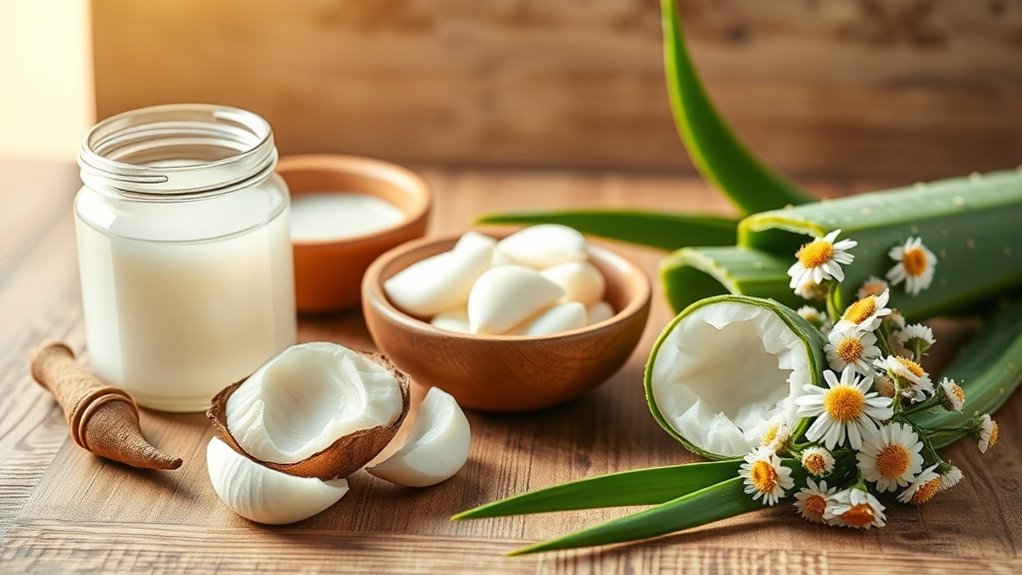Yeast Infection Relief From Ingredients Already in My Kitchen
Garlic: Nature’s Antifungal Agent
When you’re grappling with a yeast infection, you might be surprised to know that garlic can serve as an effective ally.
This kitchen staple contains antifungal properties that may help combat yeast infections naturally.
You can use it by consuming raw cloves or even creating a homemade garlic paste.
Incorporating garlic into your routine can be a beneficial addition to your yeast infection natural cures. Additionally, it is important to recognize that yeast infections are caused by the overgrowth of Candida fungus, making antifungal agents like garlic particularly useful in treatment.
Coconut Oil: A Moisturizing Defense
Coconut oil is more than just a tasty ingredient; it offers natural antifungal properties that can help combat yeast infections effectively. Its moisturizing and soothing effects not only provide relief but also contribute to preventing future irritations. Additionally, its antibacterial properties can help maintain a clean and healthy environment, further supporting the body’s defenses against infections.
Natural Antifungal Properties
Natural ingredients in your kitchen can be surprisingly effective allies in combating yeast infections, and coconut oil stands out for its impressive antifungal properties.
It contains lauric acid, which helps inhibit the growth of Candida.
By using coconut oil, you’re not just moisturizing; you’re also fighting the infection at its source.
It’s a simple yet powerful addition to your natural health routine.
Moisturizing and Soothing Effects
Although battling a yeast infection can be uncomfortable, the soothing and moisturizing effects of coconut oil can make a significant difference.
Its natural hydration properties help alleviate irritation and dryness, providing instant relief.
When applied, coconut oil forms a protective barrier, keeping the affected area moisturized.
This can often expedite healing, allowing you to feel more comfortable and at ease during recovery.
Apple Cider Vinegar: Balancing Ph Levels
When you’re dealing with a yeast infection, maintaining the right pH balance is crucial for recovery. Apple cider vinegar can help restore that balance, making it a popular home remedy. However, it’s important to know the best ways to apply it and safety precautions to take before trying it out. Incorporating apple cider vinegar into your routine can support antifungal properties, which are essential for combating Candida overgrowth.
Ph Balance Importance
Maintaining a balanced pH level is crucial for your overall vaginal health, as an imbalanced environment can lead to discomfort and infections like yeast.
When the pH leans too acidic or alkaline, it can disrupt the natural flora, making it easier for harmful bacteria and yeast to thrive.
Regularly using apple cider vinegar helps restore that balance and supports your body’s natural defenses.
Application Methods
You can easily apply apple cider vinegar in several effective ways to help balance your pH levels and alleviate yeast infection symptoms. Consider these methods:
-
Dilute with water and use as a topical rinse
-
Add to your bath for soothing relief
-
Mix into a drink for internal benefits
-
Soak a cotton ball for localized application
-
Use in your diet to enhance gut health
These options may provide comfort!
Safety Precautions
Using apple cider vinegar can be a helpful remedy for balancing pH levels and easing yeast infection symptoms, but it’s important to approach it with caution.
Always dilute it with water before applying it, as undiluted vinegar can irritate sensitive skin.
Start with a small patch test to check for adverse reactions, and consult a healthcare professional if you have any concerns.
Your comfort matters!
Yogurt: Probiotics for Gut Health
While many might associate yogurt with tasty breakfasts or snacks, its benefits extend far beyond the kitchen.
Packed with probiotics, yogurt supports gut health and can help restore balance. Enjoy these advantages:
- Enhances digestion
- Boosts immune function
- Reduces inflammation
- Promotes healthy skin
- Supports vaginal health
Incorporating yogurt into your diet can be a simple yet powerful step toward overall wellness. Additionally, using yogurt as a natural remedy can provide cooling comfort and help balance vaginal flora.
Tea Tree Oil: A Potent Essential Oil
Yogurt’s role in promoting health through probiotics is just one of many natural solutions for common issues like yeast infections.
Another powerful remedy is tea tree oil. Known for its antifungal and antibacterial properties, it can help combat yeast overgrowth. Additionally, the dual-action approach of combining tea tree oil with probiotics has shown significant efficacy in tackling yeast infections.
Just dilute a few drops in a carrier oil and apply it topically. You’ll appreciate the relief it offers your body.
Aloe Vera: Soothing Irritation
If you’ve ever experienced the discomfort of a yeast infection, you’ll appreciate the soothing qualities of aloe vera.
This natural remedy can help alleviate irritation with its gentle properties.
Here’s what aloe vera can do for you:
- Reduces inflammation
- Hydrates dry skin
- Eases itching
- Promotes healing
- Provides a cooling sensation
Using aloe vera may bring you the relief you seek.
Honey: Antimicrobial Properties
Honey isn’t just a sweet treat; it’s also a powerful ally in combating yeast infections due to its antimicrobial properties. Using honey can help soothe symptoms while targeting the underlying yeast. Here’s a quick look at its benefits:
| Benefits | Description |
|---|---|
| Antibacterial | Fights harmful bacteria |
| Antifungal | Deters yeast growth |
| Soothing | Relieves inflammation and itchiness |
| Moisturizing | Keeps the area hydrated |
| Natural | No chemical additives |
